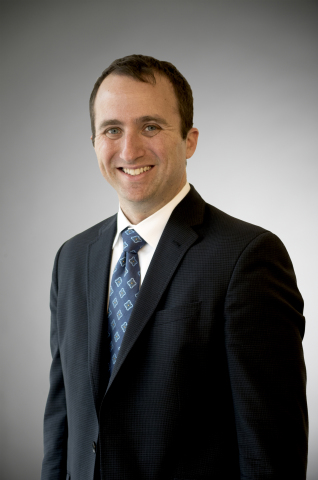
New research from PGIM, the $1.4 trillion global asset management business of Prudential Financial, Inc. (NYSE: PRU), sheds light on the use of outsourced chief investment officers (OCIOs) by defined contribution (DC) plan sponsors. While OCIOs have historically been tapped by defined benefit (DB) plan sponsors and endowments, there is a growing trend of DC plan sponsors turning to OCIO managers. PGIM’s research found that plan sponsors’ top reasons for using an OCIO manager were:
This press release features multimedia. View the full release here: https://www.businesswire.com/news/home/20201014005085/en/

Josh Cohen, Head of Institutional Defined Contribution, PGIM (Photo: Business Wire)
- The desire for expertise in implementing institutional-quality structures,
- The perceived mitigation of fiduciary risk,
- Insufficient investment sophistication.
PGIM worked with Greenwich Associates to survey 138 DC plan sponsors and with Curcio Webb to survey 20 OCIO managers representing $16.8 trillion in total assets and $1.2 trillion in OCIO assets of all plan types.1
In a divergence of opinion, OCIOs seem to underweight their expertise in implementing institutional-quality structures, indicating that the top reasons for being hired by their clients was the perceived mitigation of fiduciary risk and the plan sponsors’ lack of resources; their expertise in implementing institutional-quality structures appeared much further down the ranks.
“The move by some plan sponsors to utilize OCIOs seems to be driven, in part, by the desire to implement more best practices,” said Josh Cohen, head of institutional defined contribution at PGIM. “While some sponsors are concerned with the perceived fiduciary risk of implementing a more institutional approach, others want to do so but need help getting there. This includes adding diversified asset classes and having a thoughtful mix of active and passive investment options.”
OCIO impact on investment menu
Of the plan sponsors surveyed who are using an OCIO, 100% said they are satisfied with their current manager. Plan sponsors are primarily using their OCIO to take discretion on the hiring and firing of investment products of asset managers—including the selection of single-manager funds and off-the-shelf target-date funds (TDFs). The survey also found that the use of an OCIO can have an impact on the investment options offered to participants. For instance, when comparing plan sponsors who use an OCIO versus those who do not, plan sponsors who are using an OCIO were:
- Less likely to offer a primarily or entirely passively managed fund lineup.
- Less likely to use 100% passively managed TDFs.
- More likely to offer multi-manager structures for at least some of their menu options.
- More likely to say they offer alternative investments in the fund lineup.
Cohen said, “At PGIM, we believe providing DC plan participants access to a more institutional investment approach enhances the ability to meet retirement readiness objectives. Our research indicates that OCIOs who take on fiduciary discretion tend to prefer a more institutional approach than we otherwise tend to see in the market. It also appears that plan sponsors who have hired an OCIO incorporate more of these best practices.”
OCIO adoption still in early innings
Nevertheless, the adoption of OCIO managers in the DC space is still in its early innings. Only 15% of plan sponsors surveyed are using an OCIO manager for their entire 401(k) plan. Use of OCIOs are more common for mid-sized plans (24%) than larger plans (8%).2
Plan sponsors not currently using an OCIO manager indicated their top two reasons for refraining are to retain control of the investment decisions and because they already have this expertise internally.
“The use of OCIOs in the DC market is evolving and adoption is still in the early days with more interest from mid-sized DC plan sponsors,” said Cohen. “There continues to be opportunity for OCIOs to provide innovative solutions for plan sponsors to ultimately help their participants meet their retirement income goals.”
This research is the first iteration of a three-part series on the evolving DC landscape. For more detailed findings and further information, check out The Evolving Defined Contribution Landscape: The Expanding Role of OCIOs.
About the survey
The research was conducted by Greenwich Associates from March 5 through July 17, 2020 using an online, quantitative approach with 138 DC plan sponsors who have at least one 401(k) plan and at least $100 million in 401(k) assets. In addition, a five-question survey of 20 OCIO managers was conducted by Curcio Webb. These OCIO managers represent $16.8 trillion in total assets and $1.2 trillion in OCIO assets (all plan types).
About PGIM
PGIM, the global asset management business of Prudential Financial, Inc. (NYSE: PRU), ranks among the top 10 largest asset managers in the world* with more than $1.4 trillion in assets under management as of June 30, 2020. With offices in 16 countries, PGIM’s businesses offer a range of investment solutions for retail and institutional investors around the world across a broad range of asset classes, including public fixed income, private fixed income, fundamental equity, quantitative equity, real estate and alternatives. For more information about PGIM, visit pgim.com.
Prudential Financial, Inc. (PFI) of the United States is not affiliated in any manner with Prudential plc, incorporated in the United Kingdom or with Prudential Assurance Company, a subsidiary of M&G plc, incorporated in the United Kingdom. For more information please visit news.prudential.com.
*PGIM is the investment management business of Prudential Financial, Inc. (PFI); PFI is the 10th largest investment manager (out of 527 firms surveyed) in terms of global assets under management based on Pensions & Investments’ Top Money Managers list published on June 1, 2020. This ranking represents global assets under management by PFI as of March 31, 2020.
1 Caution: Due to small sample size (n=20), the OCIO result are for directional reference only.
2 Those considered mid-sized plans have $250 million to $499 million in 401(k) plan AUM; larger plans considered to be those with $1 billion to $5 billion in 401(k) plan AUM.
View source version on businesswire.com: https://www.businesswire.com/news/home/20201014005085/en/
Contacts:
973-902-2503
kylie.scott@pgim.com

